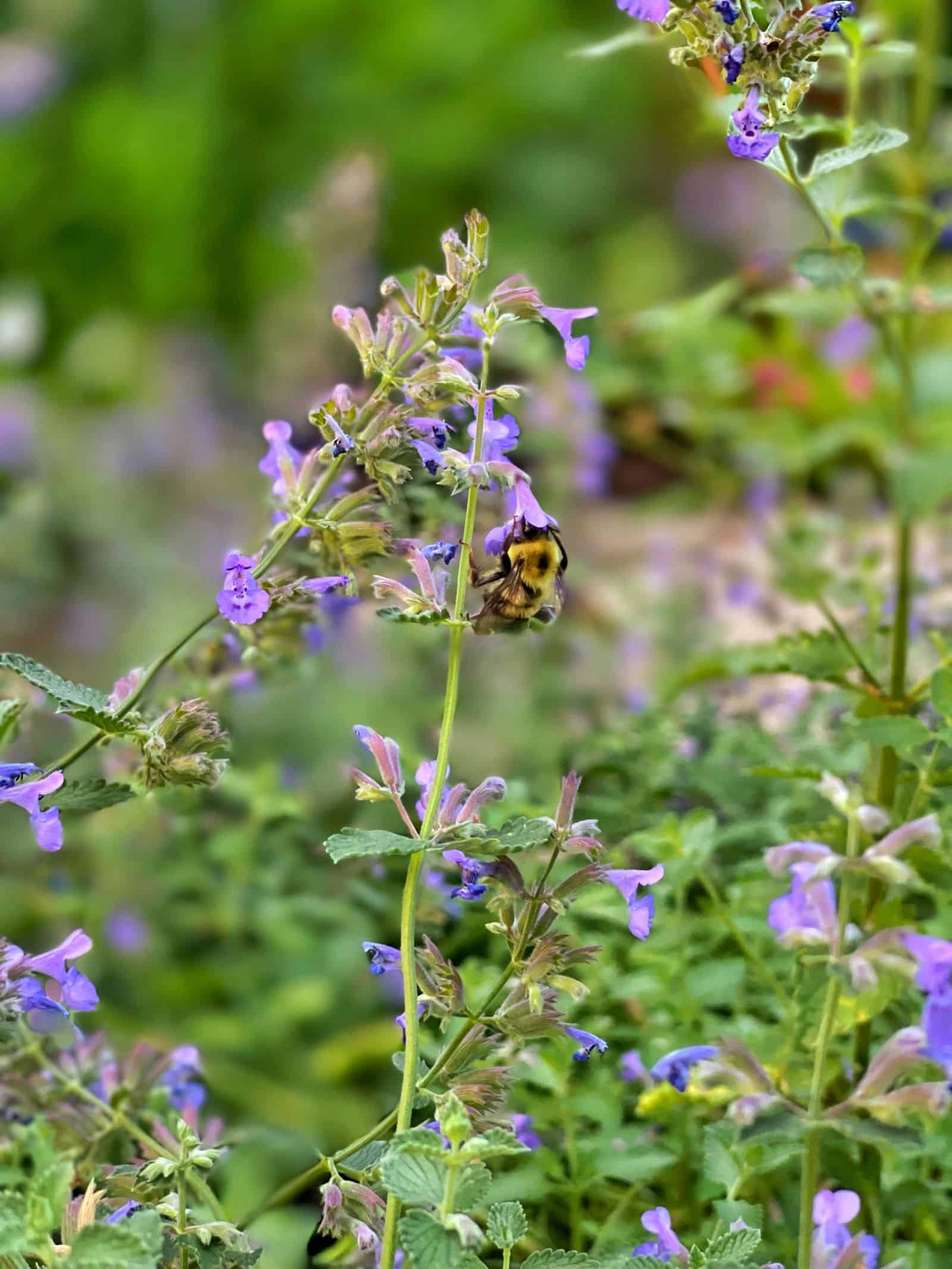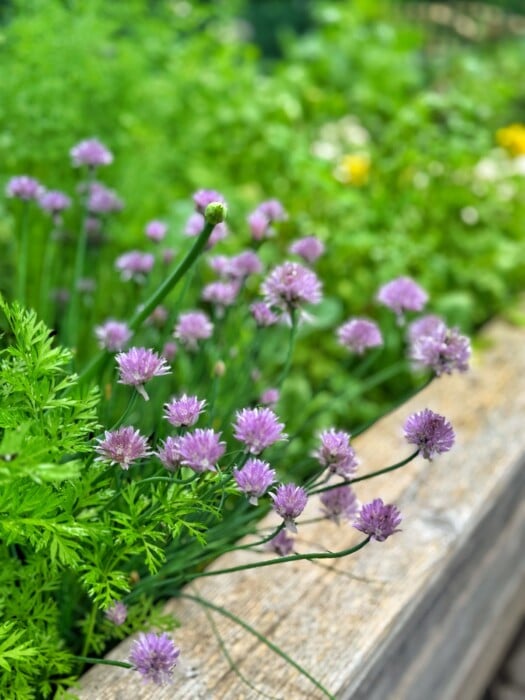Learn how to grow nepeta (catmint) for a beautiful, low-maintenance flower garden that attracts pollinators and helps repel mosquitoes!
Imagine a plant that’s as tough as it is beautiful, with billowy mounds of fragrant foliage and captivating purple blooms that dance in the breeze. That’s nepeta for you! It’s been a staple in my garden since day one, and I’m excited to share why I love it so much (and why you will too!). From attracting pollinators to repelling deer and mosquitos, nepeta is a true garden workhorse. Let’s dive into how to grow this amazing plant!
(Posts on stacyling.com may contain affiliate links. Click HERE for full disclosure.)

About Nepeta
Nepeta, also known as catmint, is an herbaceous perennial plant in the Lamiaceae (mint) family that thrives in USDA hardiness zones 3 to 8. The size of Nepeta plants can vary depending on the specific species or cultivar and growing conditions but are generally about 12 to 24 inches tall and wide. Catmint has incredibly fragrant foliage. Cats are fond of the aroma, and sometimes, I find my nepeta plants flattened out because a neighborhood feline slept in it overnight.
Why Nepeta is the Cat’s Meow (and Mine Too!)
Nepeta is a hardy perennial that comes back year after year, making it a gardener’s best friend. But that’s not all! Here’s why I’ve fallen head over heels for this charming plant:
- Low Maintenance: Nepeta is the ultimate “set it and forget it” plant. Seriously, it practically thrives on neglect!
- Pollinator Magnet: Bees, butterflies, and hummingbirds can’t resist the allure of nepeta’s fragrant flowers. I’ve even seen hummingbirds stop mid-flight to take a sip!
- Deer and Rabbit Resistant: If you’re battling those pesky herbivores, nepeta is your secret weapon. Its strong aroma sends them packing!
- Drought Tolerant: Once established, nepeta can handle dry spells like a champ. Perfect for those of us who forget to water our plants… cough cough
- Aromatic Foliage: The foliage is just as delightful as the flowers, releasing a minty fragrance when brushed against.
- Long Blooming Period: Enjoy those beautiful blooms for weeks on end!
- Versatile: Nepeta looks stunning in borders, containers, rock gardens, and even as a ground cover.
- Mosquito Repellent: Say goodbye to those pesky mosquitos! Nepeta’s scent keeps them at bay.

How to Grow Nepeta
Light Conditions For Catmint
Nepeta prefers full sun, which means it needs at least 6 hours of direct sunlight per day so it produces vibrant blooms and maintains a compact, bushy shape. However, it can tolerate light shade, especially in regions with hot summers. In areas with intense heat, partial shade during the hottest part of the day is OK.
Soil Requirements
Catmint plant likes things on the drier side and prefers well-draining soil that doesn’t stay excessively moist. Nepeta prefers a soil pH that is slightly acidic to neutral, ranging from 6.0 to 7.5. However, it is adaptable and can tolerate a fairly wide range of soil pH, from 5.0 to 8.0. It can also tolerate a variety of soil types, including sandy, loamy, rocky, and clay.
From experience, make sure you plant catmint in well-draining soil. I’ve got a garden here that holds more moisture than it loves and can attest it likes things on the drier side once established.

Planting Nepeta
Planting nepeta is a breeze. If you’ve never planted it before, here’s how to do it.
- Choose the Right Location: Nepeta prefers full sun but can tolerate light shade. Ensure your chosen spot has well-draining soil.
- Prepare the Soil: Work in some compost or well-rotted manure and leaf mold to improve soil fertility and drainage.
- Planting: Depending on the variety, you’ll space plants about 12-24 inches apart to allow for their mature size. But read the plant label for specific spacing recommendations. Dig a hole that’s about twice the size of the root ball, place the plant in, and then backfill with soil.
- Watering: Water thoroughly after planting.

Watering
Speaking of watering, keep it hydrated regularly especially during the establishment period. But once established, nepeta plants can be drought-tolerant. Follow these tips for watering catmint.
- Water at the base of the plant: Always water at the base of the plant to keep the leaves dry and prevent diseases.
- Always water in the morning if possible: Avoid watering later in the day or evening to avoid disease problems.
- Minimal Watering: Check the soil before watering to make sure the soil isn’t waterlogged. Watering once every two weeks to a month, depending on your climate and soil conditions, is usually sufficient once it is established.
In my New Jersey zone 6b garden, I let nature do it’s thing and really only water it during periods of extreme heat or dryness.

Catmint Maintenance Tips
Nepeta is a real breeze to take care of, but a little maintenance can go a long way.
- Fertilization: In general, nepeta doesn’t require fertilizers. Focus on providing good soil quality instead by amending the soil with organic matter.
- Mulching: Apply a layer of organic mulch, such as straw or wood chips, around the plant base to help retain soil moisture, suppress weeds, and maintain an even soil temperature.
- Deadheading: To encourage continuous blooming, remove spent flowers periodically. I typically don’t do this, but instead cut it back halfway once after the first flush of flowers during the season.
- Cut Back: In mid-summer when the blooms fade, trim nepeta back by about one-third to promote a flush of new growth and blooms.
- Divide: Every few years, divide catmint plant to keep it healthy and vigorous.

Common Pest and Disease Problems
Nepeta is generally a low-maintenance and hardy plant that is not highly susceptible to pests and diseases. However, like most plants, it can still encounter some issues when its growing conditions are not optimal. I’ve noticed my cat mint plants develop fungal problems if the soil doesn’t drain well. To remedy this, I dig them up and relocate them to a section of my garden that is better draining.
Growing Nepeta in Containers
Growing catmint in containers is a great option if you have limited garden space or want to enjoy its beauty on a patio, balcony, or other small outdoor areas. When I’ve grown them in containers, I keep them near my outdoor seating areas because they are considered to be plants that repel flies and mosquito.
To successfully grow them in containers year-round, choose a variety that is two times your hardiness zone. A word of advice though. If you want to grow them for more than a year or two in pots, you’ll need to either plant them in the ground or repot them with fresh potting soil.
And, if you choose the latter, gently remove as much soil off the roots as you can and then repot in fresh potting soil. You can either repot in the same container or go one size up.
Here’s how to grow catmint in containers.
- Select a container that is at least 12 inches in diameter and has drainage holes at the bottom.
- Use a high-quality, well-draining potting mix. You can also add some perlite or coarse sand to improve drainage.
- Fill the container with the potting mix, leaving a few inches of space at the top.
- Remove the nepeta plant from its nursery pot and gently loosen the roots.
- Place the plant in the container, ensuring it sits at the same depth as it was in the nursery pot.
- Fill in any gaps around the plant with more potting mix and press it down gently to secure the plant.
- Place the container in a location where it receives at least 6 hours of direct sunlight per day.
- Keep the soil consistently moist but not waterlogged. Containers tend to dry out faster than garden soil, so check the soil regularly and water when the top inch feels dry to the touch.
- Water at the base of the plant to avoid wetting the foliage, which can help prevent fungal issues.
- In regions with cold winters, you can help protect it from harsh weather by moving it to a sheltered location or insulating it with burlap or bubble wrap.
If I were growing catmint in containers and wanted to keep them year-round, I’d use an all-weather planter to help prevent cracking or damage to planters during harsh New Jersey winters.

Propagating Nepeta Plants
While you can propagate catmint a few different ways, I prefer to divide them in fall or early spring. Nepeta can be propagated by:
- Dividing
- Seeding
- Cutting
Choose the method that best suits your preferences. I like dividing them because it needs to be done anyway every few years and is just easier than seeding or taking cuttings.
While seeding nepeta or taking a cutting and dipping it into rooting hormone is pretty easy to do, it requires a little more effort. To me, dividing nepeta is a more low-maintenance approach to propagating them.
Also, since different catmint flower varieties are readily available, I’d rather save my seed starting space for other blooms like zinnias, snapdragons, calendula, etc. that are not as easy to find at the garden nursery.

How to Divide Catmint
To divide nepeta, follow these simple tips.
- Choose a cool, overcast day to divide nepeta. This will help prevent the roots from drying out. The easiest way to do this is after lots of rain because the ground will be easier to dig and the plant will have been watered well making the process a little easier.
- Dig up the entire root clump with a spade shovel. It’s easier to go around the perimeter of the plant first, and then slice through to create sections so you can remove a nepeta clump with ease.
- Gently shake off the excess soil from the roots, and then use a clean garden knife or sharp spade to divide the plant into smaller clumps. I don’t use a sharp knife for this, but I know some gardeners that do.
- Each clump should have several healthy new shoots and a good root system.
- Replant the smaller sections in their new location at the same depth they were originally growing, and water them thoroughly.
- Mulch around the plant base to help retain moisture.
- And give them lots of water after transplanting. They need it!

Nepeta FAQs
- How do I collect seeds from my nepeta plant? Allow the seedheads to dry on the plant, then remove and separate the seeds. Store them in a cool, dry place.
- Does nepeta like full sun or shade? Full sun is best for optimal growth and blooms!
- Is nepeta the same as catnip? Catnip (Nepeta cataria) is a specific type of nepeta known for its strong attraction to cats.
- How do I cut back nepeta to get a second set of blooms? Trim back by about one-third to half its height after the initial flowers fade. The best time to prune nepeta for a second set of blooms is after the initial flowers have faded, typically around July. This allows enough time for the plant to produce new growth and bloom again before the end of the growing season.
- What time of year do you plant nepeta? Spring or fall is ideal.

Favorite Varieties
I’ve got a few different varieties of nepeta growing in my gardens. But there are so many great ones out there! Here are a few you should consider planting.
- Walker’s Low
- Six Hills Giant
- Cat’s Meow
- Blue Wonder
- Purrsian Blue
- Cat’s Pajamas
- Summer Magic

Final Thoughts About Growing Catmint
I’ve been growing nepeta ever since I planted my very first perennial garden, and it’s remained a steadfast favorite all these years. It’s just so easy to grow, and the fact that it keeps those pesky deer and mosquitos away is a huge bonus in my book! Honestly, I can’t imagine my garden without the vibrant blue blooms and delightful fragrance of nepeta.
If you’re looking for a plant that’s both beautiful and beneficial, nepeta is the perfect choice. Give it a try, and I’m sure you’ll fall in love with it just as I have!
Are you growing nepeta in your garden yet? If so, what’s your favorite variety? If you’ve never planted it before, will you include it in your garden this year? Tell me about it in the comments below so we can chat more!

For more information about growing nepeta, please read this article from North Carolina State Cooperative Extension.
To drill down on more beginner gardening techniques and tips, please read these posts:
- Flower Gardening 101
- Growing a Cut Flower Garden for Beginners
- Container Garden Ideas for Beginners
- How to Start a Vegetable Garden
- Herb Gardening for Beginners
Thanks for dropping by the blog today! Enjoy your day!


More Easy-Care Flowering Plants You Might Enjoy
If you’re seeking flowers that offer beauty without the hassle, there are several easy-care options that can effortlessly brighten up your garden or living space.
Wait until you see how easy and fun these blooms are to grow!
- How to Grow Lavender
- Growing Sedum Autumn Joy
- Growing the Prettiest Heuchera Plants
- Hassle-Free Hosta Care
- How to Grow Zinnias and Enjoy the Flowers
- Growing Snapdragons
- How to Grow Bearded Iris
- 5 Reasons You Should Grow Lenten Rose
- How to Grow Peonies
- Purple Coneflower Care
- Black Eyed Susans and Their Care





